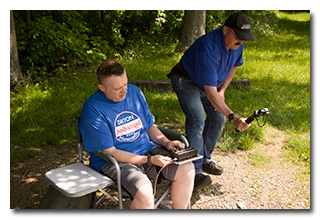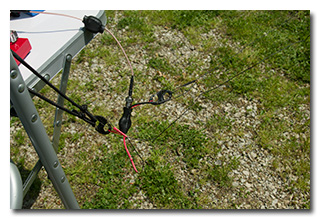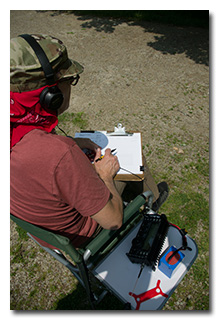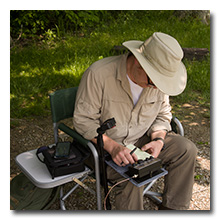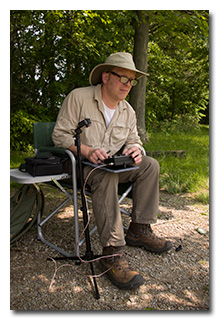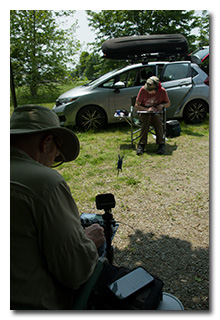
by William Eric McFadden
From the Culberson Woods State Nature Preserve website:
-
This 280-acre preserve is one of the largest remnants of the distinctive "Wet Beech Forest" which once covered the flatlands of southwestern Ohio. The first 40-acre parcel of the preserve was a gift from Mrs. Myra Culberson in 1978 in honor of her late husband, Dean A. Culberson. The forest grows on poorly drained, white clay soil which formed on the glacial materials deposited during the Illinoian glacial period.
The swamp forest is dominated by red maple and pin oak with substantial stands of shagbark hickory, shellbark hickory, swamp white oak, American elm and sweet gum. The northern shrub, winterberry, grows here near its southern limit, while the sweet gum, a southern species, is near its northern limit. Summer wildflowers include purple fringeless orchid and cardinal flower.
Pictures
- The park sign
- Charlie operates as Vince films... what?
- Eric's new Tufteln EFRW antenna and common-mode choke
- Eric operates; photo by Miles McFadden
- Thomas operates: 1 | 2; photos by Miles McFadden
- Eric and Tom operate; photo by Miles McFadden
Description
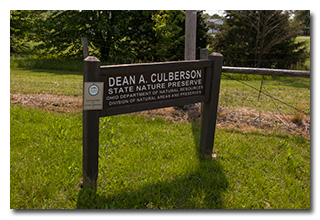 On Sunday, May 21, 2023, three members of the Southeast Ohio Radio Adventure Team
performed successful activations of Culberson Woods State Nature Preserve (K-9402) in Ohio as part of the Parks on the Air
(POTA; link) program.
On Sunday, May 21, 2023, three members of the Southeast Ohio Radio Adventure Team
performed successful activations of Culberson Woods State Nature Preserve (K-9402) in Ohio as part of the Parks on the Air
(POTA; link) program.
Following a Friday and a Saturday spent at Hamvention (link) at Greene County Fairgrounds in Xenia, Ohio, on a day with dismal-looking solar numbers, and following successful activations of Cowan Lake State Park (report), Eric McFadden, WD8RIF; Thomas Witherspoon, K4SWL; and Miles McFadden, KD8KNC, visited the Culberson Woods and were joined by Charlie Brown, NJ7V (YouTube), and Vince d'Eon, VE6LK/AI7LK (website). The group arrived at the location at about 1545 UTC.
The group immediately noticed that unless one or two of the operators wished to hike into the woods, the available space to set up stations in parking area was small. Due to time constraints, Vince not to operate, and Charlie would operate first so Vince could get him to the airport in time for his flight back to Arizona. Thomas impressed the others by neatly throwing a line through a tree with just one throw; he quickly pulled a wire antenna into place and deployed his Elecraft KX2 on one of Eric's folding camp-chairs. Meanwhile, Eric strapped his 31' Jackite telescoping fiberglass pole to a fencepost and pulled his brand-new Tufteln 35' End-Fed Random Wire antenna (link)—a completely unexpected gift from the builder, Joshua Ellis, N5FY—into place and deployed his Elecraft KX3 on his second folding camp-chair. Charlie and and Eric were both on the air about 1555 UTC.
As they had hoped, cell-signal was good at this location and the operators would be able to spot themselves on the POTA Spots website and to use POTA Spots to identify possible Park-to-Park (P2P) QSOs. What no one had hoped for or even anticipated was the loudness of the car, truck, and motorcycle traffic on the nearby County Rd 730; it was so loud that it would, at times, be hard to hear the stations the operators were trying to work.
Because the very close proximity of the station allowed for serious inter-station interference, the group decided to allow Charlie to validate his activation before the rest of them started their activations. Thomas manually spotted Charlie to POTA Spots. When Charlie started to call CQ, Eric called him for a quick P2P QSO.
Between the end of the activations at Cowan Lake State Park (report) and the start of this one, the Earth had been struck by an X-class solar flare and the resulting radio blackout made Charlie's job of making QSOs very challenging. After Charlie's seventh QSO, responses to his calls of CQ seemed to just stop. Fortunately, a remedy was at-hand: both Thomas and Vince used Eric's station to provide two P2P QSOs on HF, and Miles and Charlie used HTs on 2m FM to give Charlie his tenth and final QSO. Charlie has published a video featuring this activation: POTA Park Qualification: The Struggle to Reach 10 Contacts.
After Vince and Charlie made their good-byes, Eric and Thomas sat down at their own radios and began their own activations, trying to stay on bands that were not harmonically related. However, the close proximity of the stations, and the antennas that were nearly parallel, ensured strong inter-station interference even at 5w output.
Eric started his operation by finding a frequency to run on 20m and was pleased to be auto-spotted on POTA Spots. Eric's first QSO in this run came at 1621 UTC with W4STT in Florida. This was followed at 1624 UTC by an ESP-level P2P QSO with KE5ES; Eric copied that KE5ES was at a park but couldn't copy the park designator.
After several minutes of fruitless calling, at 1632 UTC Eric switched to 30m work Thomas there.
Finding a frequency to run on 40m, Eric's first QSO in this run came at 1635 UTC with N5FY in Georgia—and Eric didn't realize until later that this was Joshua Ellis, the maker of the antenna Eric was using. Eric managed three additional QSOs on 40m in the following five minutes: KZ4KX in Kentucky, N1XV in New Jersey, and K4ISW in Virginia.
After the slow run on 40m, at 1642 UTC Eric switched to 17m to work Thomas there.
Returning to 40m to run, at 1643 UTC he made yet another P2P QSO with Thomas. QSOs came slowly, with Eric's fifth QSO in this run being another ESP-level P2P coming at 1702 UTC with W4EMB who was performing an activation of Stewart State Forest (K-5502) in Tennessee. This run included a P2P QSO with N2GSL who was performing a two-fer activation of John Bryan State Park (K-1964) and Clifton Gorge State Nature Preserve (K-7848) in Ohio and QSOs with operators located in Ohio (2), South Carolina, North Carolina, and Tennessee.
In all, Eric made fourteen QSOs, including four P2P QSOs for Culberson Woods State Nature Preserve and three P2P QSO with another park. All of Eric's QSOs were CW and were made at five watts output.
Thomas validated his activation by completing eleven QSOs, and he also worked Joshua, N5FY. He has published a report about this activation: QRP POTA with Friends: Two Park Activations with VE6LK, NJ7V, WD8RIF, and KD8KNC!.
As previously mentioned, Charlie validated his activation with ten QSOs. Also, as previously mentioned, Miles made one QSO as a POTA Hunter.
During the operation, while he was running on 40m, Eric added a 40m bandpass filter (BPF) to his station, but this didn't really help with the interference between his station and Thomas's. The bandpass filter was located between his KX3's internal antenna tuner and the antenna, and it really should have been between the KX3 and the antenna tuner so that the bandpass filter was seeing 50Ω in both directions, but Eric lacked the proper connectors to deploy his LDG Z11 external antenna tuner in this configuration.
Eric found that the 35' Tufteln EFRW antenna deployed easily and the antenna worked well, particularly given the lousy band conditions present during the activation. It's clear Joshua, N5FY, has put a great deal of thought into the design of this antenna.
(return)
